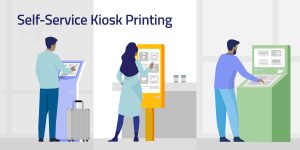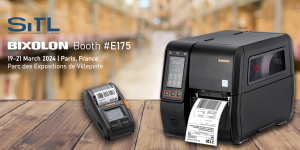
In a world where businesses are increasingly committed to Environmental, Social, and Governance (ESG) strategies, the pressure on IT teams to enhance sustainability credentials has never been greater. A key focus is the reduction of paper consumption, yet in many industries, the complete elimination of paper remains impractical due to both practical and regulatory reasons. From retail to hospitality, printed receipts, price tags and delivery notes are still essential – so what is the most environmentally friendly approach to printing? In this blog, we explore the innovative printing solutions that are available to businesses.
The Sustainability Challenge
Businesses globally are continually exploring technology innovation to reduce carbon emissions and meet corporate and regulatory goals for improved sustainability. The use of paper is a key area of innovation, with many companies looking at ways of reducing print to cut consumption of both paper and power. However, completely eradicating paper usage is often not attainable. In retail, for example, providing customers with a physical receipt is a necessity, and capturing email information at the point of sale can be complex and time consuming, thus damaging the customer experience. Moreover, many customers do not want to share email addresses or phone numbers, making it essential to provide a paper receipt. Attention has turned, therefore, to the paper itself, leading to the creation of environmentally friendly paper products.
Blue Paper Innovation
One solution lies in the paper itself.Environmentally friendly paper products, such as Koehler’s Blue4est® thermal paper are an example of innovation in paper technology. This blue paper uses a mechanical rather than chemical reaction to create prints. This innovation not only makes the paper recyclable but also certifies it to be used directly with food products, providing an additional benefit to both the hospitality industry and retailers selling loose foods.
Flexible Printing
Shifting to blue receipts shows customers that the business is meeting its customers’ demands for more environmentally conscious products and services and is committed to sustainability. The challenge for the printer industry is that this mechanical process is very different to traditional chemical printing and therefore requires a new approach. The paper takes longer to react, for example, which means the print process has to be slowed, while the print density needs to be increased to optimise the output. Companies will not use blue paper for all uses. Intelligent printers that use optical sensors can automatically switch between traditional and blue paper types, detecting the paper and adjusting settings automatically.
Minimising Consumption
In addition to embracing environmentally friendly paper, retailers can explore intelligent printers that include paper saving options. This includes minimising space between lines, reducing print size, and exploring pressure sensitive, Linerless labels. Linerless labels in particular eliminate the backing which typically ends up as landfill waste. Furthermore, because Linerless labels are much thinner due to the lack of backing, each roll provides around 40% more paper length compared to traditional label paper, extending its usage and reducing the carbon emissions associated with both shipping and storage. The saving is amplified further, when you consider that each label can be cut to length on demand, resulting in an optimal use of label rolls, with minimal waste.
Paper consumption is a key consideration for any ESG strategy. Embracing intelligent printers and environmentally friendly paper to minimise usage provides an immediate win for any retailer or hospitality provider. The ability to move seamlessly between traditional and new environmentally friendly blue paper not only supports sustainability goals but also enhances a company’s environmental credentials. With customers increasingly intrigued by the eco-friendly blue receipts, this innovation becomes a powerful tool for reinforcing a commitment to sustainability in the business landscape.
Find out more about BIXOLON’s key printing solutions from its sustainable printing range
- 3-inch (up to 83mm) Linerless label and receipt printer
- Optional taken sensor: Label will not continue to print until current label is removed to prevent jamming
- World’s first Linerless label printer equipped with specialised back-feed technology
- A water-resistant cover protects the main board from water and moisture (IP21 certified)
- 4-inch (114mm) dedicated permanent Linerless label printer
- Linerless printing speed up to 6ips (152mm/sec) in 203 or 300dpi print resolution
- Guillotine cutting system with a peel-off sensor, Taken Sensor™
- Dual-mode Bluetooth (V4.2 Classic and LE) or Dual-band WLAN (5GHz and 2.4 GHz) connectivity
- 4-inch (112mm) mobile liner and Linerless label printer
- Supporting Smart Media Detection™
- Fully compatible with SLCS, BPL-Z™, BPL-C™ and BXL / POS: Interchanged without setting the mode
- Simultaneously connects both Bluetooth 5.0 (MFi certified) and Dual-band WLAN (2.4GHz and 5GHz)
- 3-inch (80mm) receipt and ticket printer
- Print speeds of up to 400mm/sec with 180 or 203dpi print resolution
- Supports the Visibility Intelligence ™ function for optimal print quality on Blue4est® paper
- With easy drop in identification for white or blue paper
- Offers a paper savings up to 25% of paper per roll with three compression levels
- 3-inch (80mm) receipt and ticket printer
- Prints speeds of up to 350mm/sec with 180 or 203dpi print resolution
- Supports Blue4est® paper receipting (SRP-380K model only)
- Auto receipt resize, 80 to 58mm with optional auto paper reduction function
- Offers a paper savings up to 25% of paper per roll
For more information on BIXOLON hospitality printing solutions visit the BIXOLON website or contact your local BIXOLON sales representative.



